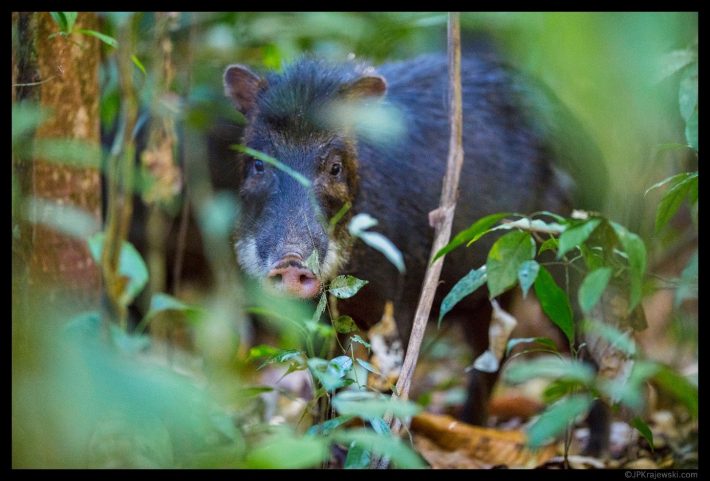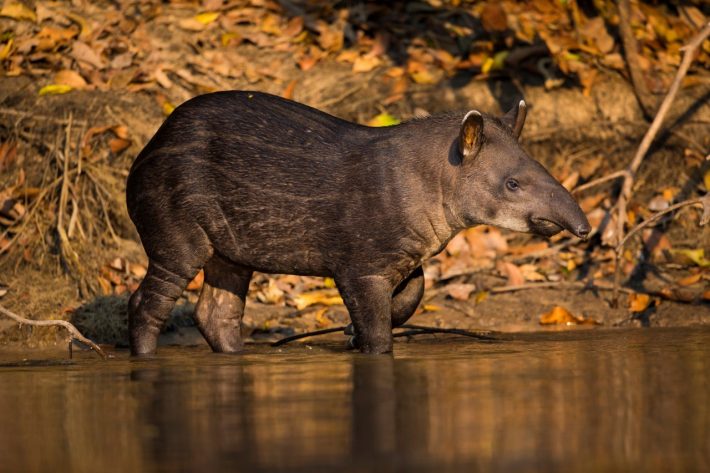Large herbivores increase biodiversity in tropical forests
Sao Paulo State University press release.
Joint extinction of tapirs and peccaries leads to reduction in tropical forest diversity, finds 10 year study published in Journal of Ecology.

Tapirs and peccaries are the largest herbivorous mammals that used to roam in most of South American rainforests. Increasing hunting and deforestation are threatening these mammals in most of their distribution, but the impact of this loss on such hyper-diverse forests is not well understood.
A team of researchers from São Paulo State University in Brazil (UNESP) found that the joint extinction of tapirs and peccaries caused a reduction in forest diversity. Based on a 10 year experiment the researchers found that communities of plants are more dissimilar only where both herbivores are simultaneously present, and that on forests where only one of the species occur, the diversity is lower. Their findings, reported in the British Ecological Society’s Journal of Ecology, suggest a complementary ecological function of these species.
White lipped peccaries are voracious seed and seedling predators that live in large groups of extended families often in the excess of the hundred individuals, whose foraging and trampling strongly reduce the number of plants on the understory of tropical rainforests. Tapirs, in contrast, are solitary and feed on the leaves and fruits of a vast array of plant species but have no impact on the number of plants. However, tapirs consume large amounts of fruits that then they defecate elsewhere, moving seeds from one place of the forest to another where these might eventually turn into fully-grown trees.
“Whilst peccaries behave like little bulldozers moving across the forest, tapirs are gentle giants transporting seeds on their stomachs. They play ecologically distinct roles”
says Nacho Villar, leading author of the study. Both species move across large tracts of tropical forests, so that the disturbance caused by peccaries overlaps with the movement of seeds caused by tapirs. “We believe that the disturbance caused by white lipped peccaries might improve the chances of seeds from the multiple species dispersed by tapirs to become fully grown trees, thus increasing forest-wide diversity” says Dr. Villar.
The standard model (aka “Janzen-Connell model”) suggests that natural specialized enemies, such as invertebrates, and parasitic fungi and bacteria, maintain plant diversity in tropical forests. “Unlike specialized feeders, large tropical forest herbivores are generalist consumers, they feed on a variety of resources. In addition, many of these large herbivores eat and disperse seeds across large distances, which has a positive (technically termed “mutualistic”) effect on plants by increasing the chances to escape from specialized enemies. Thus, their effects on forest diversity does not fit well within the standard model. Both processes might be operating in parallel to shape forest diversity.”

Illegal hunting and conversion of forests into agricultural land are key drivers threatening tapirs and peccaries across South America, with many populations being locally extinct across many parts of the tropical forests. Previous studies have speculated with the potential “ecosystem engineering” of both species, but this study provides strong evidence suggesting that only when in combination they have a substantial impact on diversity.
“The demise of these species from the tropical forests of South America might have a substantial impact on forest dynamics, perhaps equivalent to the removal of elephants from African and Asian forests, or the wildebeest in savannas. Furthermore, white lipped peccaries are one of the favorite preys of jaguars, the top predator in South American tropical forests, so their local extinction ramifies upwards and downwards across the trophic chain” adds Dr. Villar.
“We are just starting to understand the ecological consequences of the joint extinction of populations of large herbivores from tropical forests. This is probably just the tip of the iceberg. We are conducting novel research linking removal of these iconic mammals, the aboveground forest and belowground soil communities, and training a new generation of tropical forest ecologists to integrate their passion for natural history with a system perspective of tropical forests. We need this science done before it’s too late, and long-term experimental projects like these are critical and instrumental to achieve this target”.
The long-term experiment, funded by the BIOTA programme of the São Paulo Research Foundation FAPESP, started in 2009 and is coordinated by Prof. Mauro Galetti. Within this project, a large number of ongoing strategic research subprojects lead by postdoctoral, doctoral, master and graduate students are generating unprecedented insights into the effects of defaunation from large herbivores on the diversity and dynamics of tropical forests.
Read full study (free to read for a limited time):
Villar N, Siqueira T, Zipparro V, et al. The cryptic regulation of diversity by functionally complementary large tropical forest herbivores. J Ecol. 2019;00:1–12. https://doi.org/10.1111/1365-2745.13257
Media Contact:
Dr. Nacho Villar (lead author)
LaBiC Conservation Biology Lab
UNESP Rio Claro, SP, Brazil
Email: nachoprad@gmail.com
Like what we stand for?
Support our mission and help develop the next generation of ecologists by donating to the British Ecological Society.